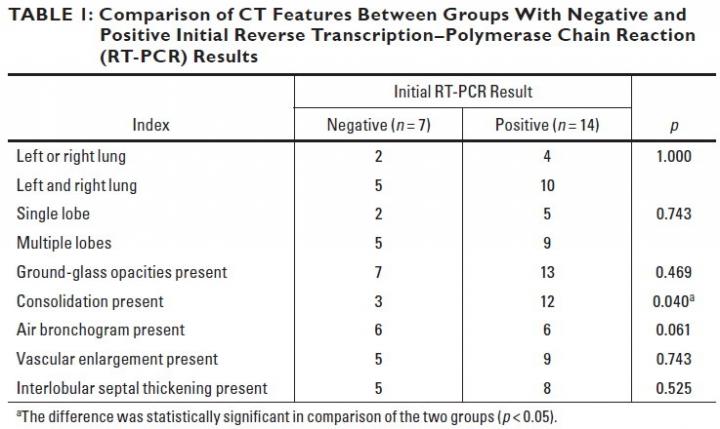CT of patient cohort with negative initial nucleic acid test results less likely to indicate pulmonary consolidation (p

Credit: American Journal of Roentgenology (AJR)
Leesburg, VA, June 18, 2020–An open-access American Journal of Roentgenology (AJR) article exploring the diagnostic value of chest CT for coronavirus disease (COVID-19) pneumonia–especially for patients with negative initial results of reverse transcription-polymerase chain reaction (RT-PCR) testing–found that the less pulmonary consolidation on chest CT, the greater the possibility of negative initial RT-PCR results.
From January 19 to February 20, 2020, lead investigator Dandan Chen of Guangzhou First People’s Hospital in China obtained the admission data of 21 patients (nine men, 12 women; age range, 26-90 years) with confirmed COVID-19 pneumonia from five nonspecialized infectious disease hospitals across Guangzhou.
After undergoing chest CT and swab RT-PCR tests within 3 days, patients were divided into two groups: seven patients with negative initial results (who were found to have positive results after a second RT-PCR test 2 days later) and 14 patients with initial positive results.
“Most of the COVID-19 lesions were located in multiple lobes (67%) in both lungs (72%) in our study,” Chen et al. wrote, adding that the CT findings observed most frequently were ground-glass opacities (95%) and consolidation (72%) with subpleural distribution (100%). “Otherwise,” they continued, “33% of patients had other lesions around the bronchovascular bundle.”
Additional chest CT findings identified by Chen and colleagues included air bronchogram (57%), vascular enlargement (67%), interlobular septal thickening (62%), and pleural effusions (19%).
Ultimately, compared with the positive initial RT-PCR results group, CT of the group with negative initial RT-PCR results was less likely to indicate pulmonary consolidation (p
Acknowledging that RT-PCR detection can be affected by laboratory reagents, test method, and subjective operability, Chen noted that, theoretically, the multicenter nature of this study–five hospitals in four districts of Guangzhou (13 cases in Huadu, four in Baiyun, three in Yuexiu, one in Nansha)–should have reduced interference by such factors.
“When patients with suspected COVID-19 pneumonia who have an epidemiologic history and typical CT features have negative initial RT-PCR results,” the authors of this AJR article concluded, “repeated RT-PCR tests and patient isolation should be considered.”
###
Founded in 1900, the American Roentgen Ray Society (ARRS) is the first and oldest radiological society in North America, dedicated to the advancement of medicine through the profession of radiology and its allied sciences. An international forum for progress in medical imaging since the discovery of the x-ray, ARRS maintains its mission of improving health through a community committed to advancing knowledge and skills with an annual scientific meeting, monthly publication of the peer-reviewed American Journal of Roentgenology (AJR), quarterly issues of InPractice magazine, AJR Live Webinars and Podcasts, topical symposia, print and online educational materials, as well as awarding scholarships via The Roentgen Fund®.
Media Contact
Logan K. Young
[email protected]
Original Source
https:/
Related Journal Article
http://dx.




